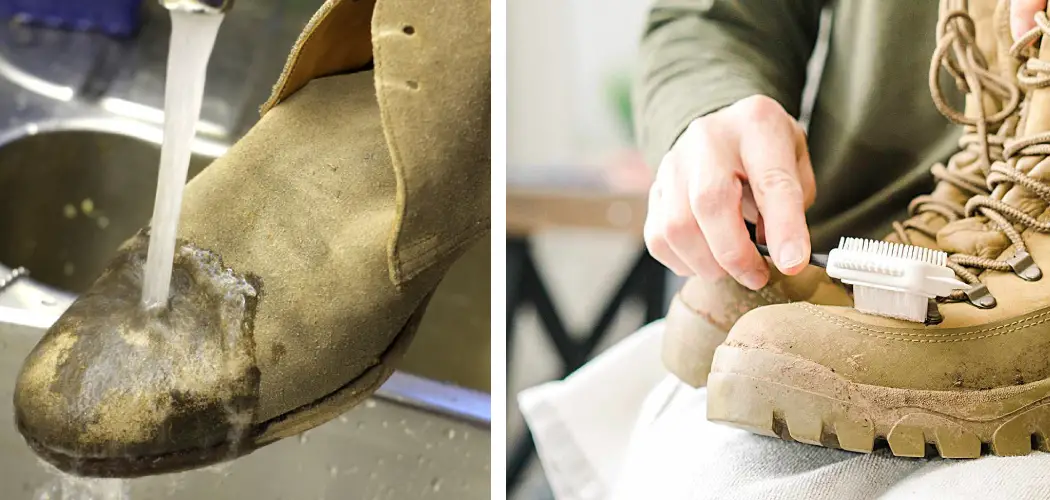Are you an army personnel who just got a new pair of combat boots? Or are you someone who loves the rugged and tough look of combat boots and wants to add them to your shoe collection? No matter what your reason is, taking care of combat boots is essential for their longevity.
Combat boots are not only a staple for military personnel but have also become a fashionable accessory for everyday wear. Their durable design and rugged build make them perfect for tackling tough terrains and challenging weather conditions. However, this also means they can get quite dirty and require proper care to maintain their condition and extend their lifespan. Washing combat boots properly is crucial in preserving their integrity and functionality.
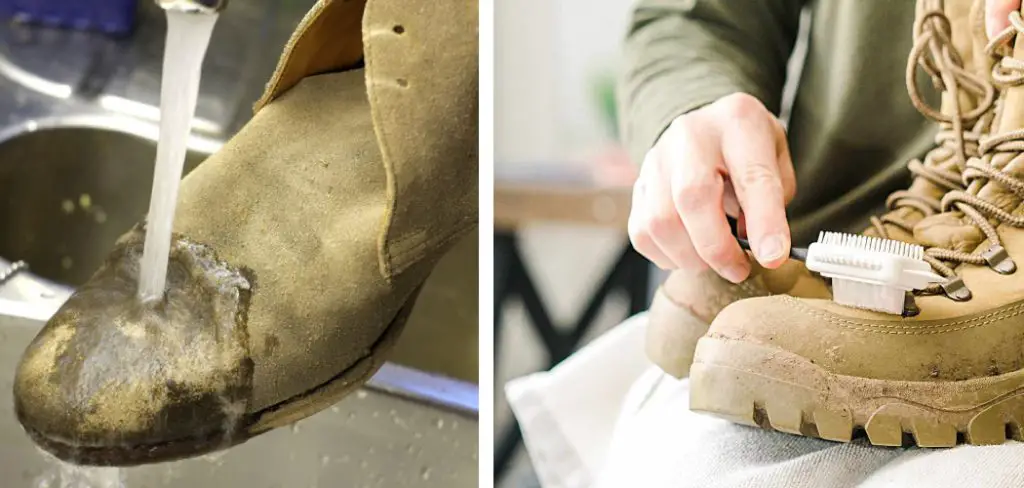
This guide will introduce you to the steps and precautions necessary on how to wash combat boots, ensuring they continue to serve you well, whether on duty or on the streets.
What are the Benefits of Washing Combat Boots Regularly?
Combat boots are designed to endure harsh conditions and keep your feet protected. However, they also get exposed to sweat, dirt, mud, and other elements during use. If not cleaned regularly, these substances can build up on the boots’ surface, leading to deterioration and discoloration over time.
Washing your combat boots frequently will help remove this buildup and prevent them from becoming stiff, smelly, or damaged. It also helps to maintain their appearance, making them look new and presentable.
Moreover, washing combat boots can help prevent the growth of bacteria and fungus that can cause unpleasant odors and infections. This is especially important for military personnel who may be stationed in humid or wet environments where foot hygiene is crucial.
Precautions Before Washing Combat Boots
Before you start the washing process, there are a few precautions to keep in mind:
- Check the Label: Some combat boots come with specific instructions on how to wash them. Make sure to read and follow these instructions carefully.
- Remove Any Excess Dirt or Debris: Use a soft brush or cloth to remove any visible mud, dust, or debris from the boots’ surface. This will make the washing process more effective.
- Remove Laces and Insoles: Remove the laces and insoles of your combat boots before washing. This will ensure that these parts are thoroughly cleaned and prevent damage during the wash.
- Use a Mild Detergent: Avoid using harsh chemicals or bleach when washing your combat boots, as they can damage the material and affect their waterproofing.
- Wash by Hand: Combat boots are not suitable for machine washing. It is best to wash them by hand to ensure gentle cleaning and prevent any potential damage.
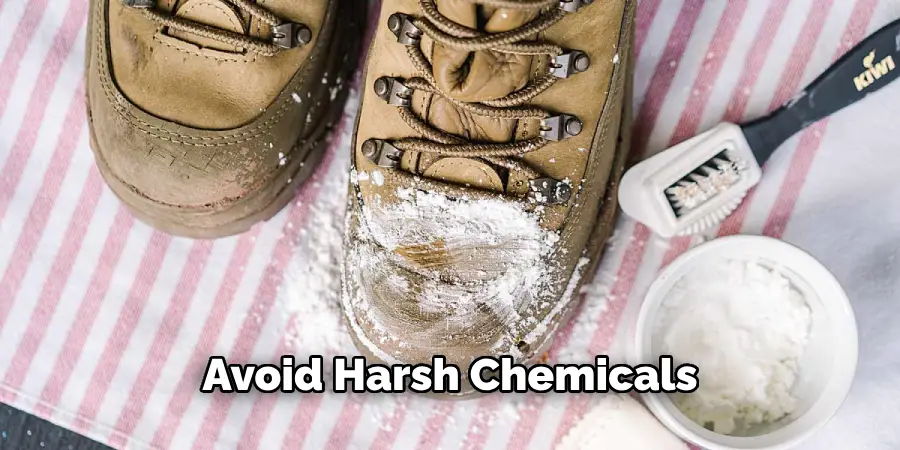
These precautions will help protect your combat boots and ensure they are cleaned safely and effectively.
What Will You Need?
- A bucket or sink
- Mild detergent
- Soft brush or cloth
- Towel for drying
- Optional: Waterproofing spray for leather boots
Once you have all the necessary items, follow these steps to wash your combat boots effectively.
10 Easy Steps on How to Wash Combat Boots
Step 1. Use Lukewarm Water:
Fill a bucket or sink with lukewarm water. Ensure the water is not too hot or too cold, as extreme temperatures can damage the material of your combat boots, especially if they are made of leather. Lukewarm water is ideal for loosening dirt and grime without harming the boots’ structure or finish.
Step 2. Prepare Cleaning Solution:
Add a small amount of mild detergent to the lukewarm water and gently mix to create a cleaning solution. To avoid damaging the material of your combat boots, it’s essential to use a detergent free from harsh chemicals or bleach. The goal is to have a solution that can effectively remove dirt and stains without compromising the integrity of the boots. Stir the solution until it’s well-mixed, but ensure it’s not too sudsy, as too much soap can leave a residue that might be difficult to rinse off.
Step 3. Submerge and Scrub the Boots:
Carefully submerge your combat boots in the prepared cleaning solution. Use a soft brush or cloth to gently scrub the surface of the boots. Focus on areas that are especially dirty or have noticeable stains. The goal here is not to scrub aggressively but to apply firm and gentle pressure to clean the material without causing damage. Ensure you reach all parts of the boots, including crevices and seams where dirt and grime often accumulate.
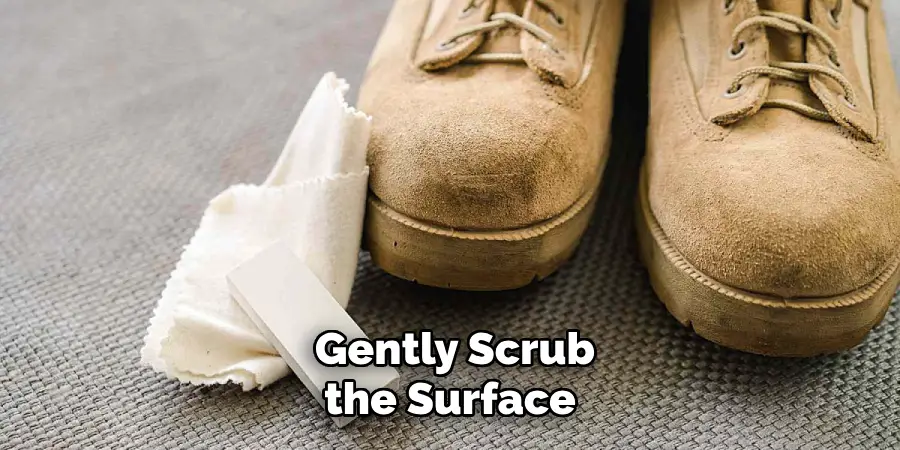
Step 4. Rinse Thoroughly:
After scrubbing the boots, rinse them thoroughly under lukewarm running water. Remove all traces of detergent from the boots, as any remaining soap residue can attract more dirt and lead to material deterioration. Rinse until the water runs clear, indicating that the boots are completely free of cleaning solution. Be gentle during this process to preserve the integrity of the boots’ material and construction.
Step 5. Dry Your Boots Properly:
Once you have thoroughly rinsed your combat boots, it’s crucial to dry them properly to prevent any damage or mold growth. Avoid placing them directly in sunlight or near a heat source, as this can cause the material to warp or crack. Instead, use a clean, dry towel to gently pat the boots, removing as much water as possible. Then, allow them to air dry in a well-ventilated area. If necessary, stuff the boots with paper or a towel to help them maintain their shape and absorb moisture from the inside. Remember to replace the stuffing as it becomes damp. Dry your boots completely before wearing or storing them away to ensure longevity and performance.
Step 6. Recondition the Leather (Optional):
After your combat boots are completely dry, consider reconditioning the leather to restore moisture and flexibility. Use a quality leather conditioner and apply it gently over the surface of the boots using a soft cloth. This step is crucial for maintaining the leather’s suppleness and preventing it from drying out or cracking. Work the conditioner in small circular motions, ensuring that it is evenly applied across the entire surface. Allow the conditioner to absorb and dry before moving on to the next step. Not only does this process help keep the leather in top condition and enhances the boots’ resistance to future soiling and makes subsequent cleanings easier.
Step 7. Re-lace and Reinsert Insoles:
Once your combat boots are completely dry and the leather has been conditioned, it’s time to re-lace them and reinsert the insoles. Start by ensuring the insoles are completely dry before placing them back inside the boots. This will ensure your feet stay comfortable and help prevent the growth of bacteria caused by moisture. Then, carefully lace your boots up. Various lacing techniques are available, so consider choosing one that provides the best fit and support for your needs. Re-lacing your boots prepares them for wear and allows you to adjust the fit as needed for maximum comfort and effectiveness.
Step 8. Apply Waterproofing Treatment (Optional):
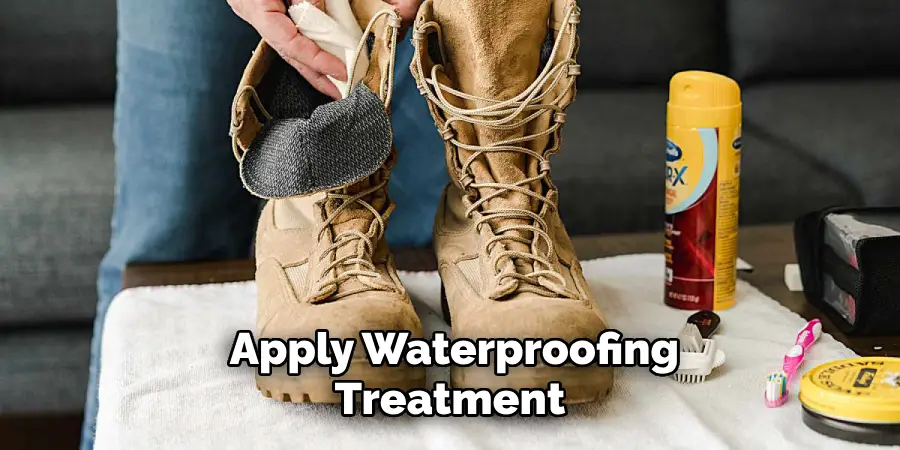
If your combat boots are made of leather or a material that benefits from waterproofing, consider applying a waterproofing treatment once they are clean and dry. Choose a waterproofing product that is appropriate for the material of your boots and follow the manufacturer’s instructions for application. This step is critical if you frequently use your boots in wet conditions, as it adds an extra layer of protection against moisture. Applying a waterproofing treatment can extend the lifespan of your boots and keep your feet dry in adverse weather conditions. Allow the treatment to fully dry before wearing or storing your boots.
Step 9. Perform a Final Inspection:
Before wearing your combat boots or storing them away, perform a final inspection to ensure they are completely clean, dry, and in good condition. Check for any missed spots during the cleaning process, areas where the material might be compromised, or signs of wear that could affect the boots’ functionality. Pay close attention to the soles and seams, as these areas are especially prone to damage. If you find any issues, address them promptly to prevent further deterioration. This step is crucial for maintaining the longevity and performance of your combat boots, ensuring they are ready for your next adventure or mission.
Step 10. Store Your Boots Properly:
Proper storage is key to extending the life of your combat boots. Store them in a cool, dry place away from direct sunlight to prevent the leather from drying out or the colors from fading. Avoid storing your boots in plastic bags or tightly sealed containers, as these can trap moisture and lead to mold or mildew growth. Instead, consider using a breathable shoe bag or leaving them in an open area with good ventilation. If you won’t be wearing the boots for an extended period, stuffing them with newspaper or a shoe tree can help maintain their shape and absorb any residual moisture. Proper storage will ensure your boots remain in top condition and are always ready for use.
By following these steps, you can effectively clean and maintain your combat boots, keeping them in top condition for all your outdoor or military activities.
5 Additional Tips and Tricks
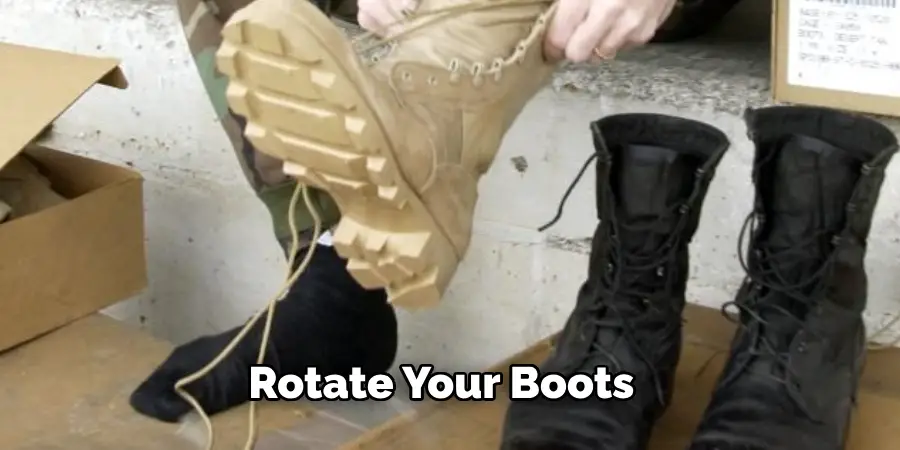
- Use a Soft-Bristled Brush for Suede: If your combat boots are made of suede, opt for a soft-bristled brush specifically designed for suede. This prevents damage to the delicate surface while effectively removing dirt and dust.
- Apply Stain Repellent Before First Use: Before you put your boots to the test, apply a stain repellent. This preemptive step makes future cleaning sessions much easier, as it prevents dirt and grime from penetrating deep into the material.
- Rotate Wearing to Extend Life: Giving your boots a rest day between wears allows them to air out and reduces the build-up of moisture and bacteria. This not only keeps them fresher but can also prolong their lifespan.
- Deodorize Naturally: To keep your combat boots smelling fresh, sprinkle baking soda inside them and leave overnight. The baking soda will absorb odors naturally. Just remember to tap out the baking soda before wearing them again.
- Treat Scuffs Immediately: When you notice scuffs or minor damage, address it immediately. Using a matching shoe polish or a specialized suede eraser can help maintain the boots’ appearance and prevent minor issues from becoming major ones.
With these additional tips, you can ensure your combat boots remain in top condition and serve you well for years to come.
5 Things You Should Avoid When Washing Combat Boots
- Do Not Submerge in Water: Avoid submerging your combat boots entirely in water. This can cause the leather or materials to warp, weaken, or become misshapen. Always opt for spot cleaning or gentle wiping.
- Avoid Harsh Chemicals: Harsh chemicals or cleaning agents can damage the material of your boots. Stick to mild soaps or products specifically designed for boot care to prevent material deterioration.
- Steer Clear of Direct Heat Sources: When drying your combat boots, never place them too close to direct heat sources such as radiators, blow dryers, or direct sunlight. Excessive heat can cause the material to crack or fade.
- Don’t Ignore Manufacturer’s Care Instructions: Always refer to the manufacturer’s care guide before cleaning your boots. Ignoring these guidelines can lead to irreversible damage or void warranties.
- Don’t Rush the Drying Process: It is imperative to allow your combat boots to dry naturally. Rushing this process by squeezing, twisting, or using an external heat source can damage the boots’ structure and integrity.
By avoiding these common mistakes, you can ensure your combat boots remain durable and reliable for your next mission or outdoor adventure.

Some Frequently Asked Questions
1. Are Combat Boots Warm?
Many combat boots are designed to provide warmth and insulation, especially for outdoor activities in cold weather. Materials such as leather and Gore-Tex offer excellent protection against the elements, while features like insulation and waterproofing add an extra layer of warmth.
However, not all combat boots are equally warm. Some styles prioritize breathability over insulation, making them more suitable for warmer climates. It’s essential to consider the intended use and climate before purchasing combat boots to ensure they meet your specific needs for warmth and comfort.
2. Can Combat Boots Get Wet?
Yes, combat boots can get wet. They are designed to withstand harsh conditions and are often used in wet or muddy environments. However, continuous exposure to moisture can damage the material and shorten the lifespan of your boots. This is why it’s important to properly clean and dry them after use in wet conditions and apply a waterproofing treatment when needed.
Additionally, prolonged exposure to water can also cause discomfort and blisters for the wearer. To avoid this, wearing moisture-wicking socks and changing them regularly if your boots get wet is important. Properly maintaining your combat boots will prolong their lifespan and ensure they remain comfortable and functional in any weather conditions.
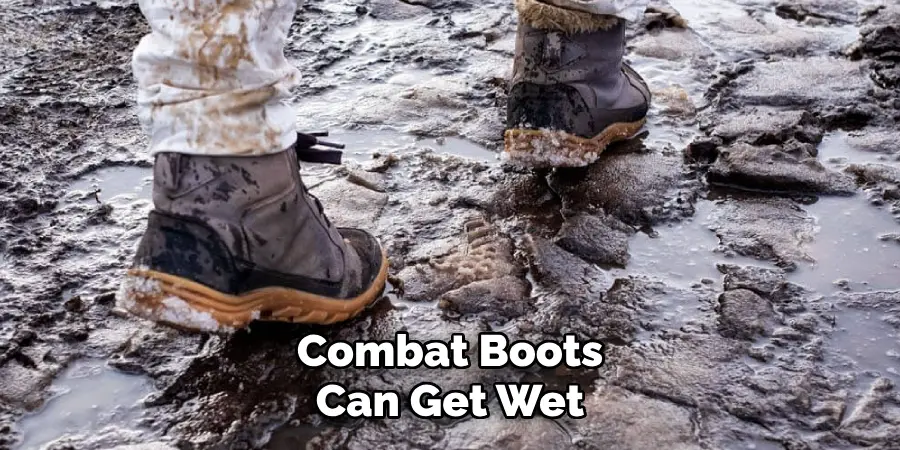
3. Why Do Soldiers Wear Combat Boots?
Combat boots are essential to a soldier’s uniform and have been used for centuries in military operations. They are designed to provide protection, durability, and functionality in various terrains and weather conditions. The sturdy construction of combat boots helps soldiers maintain proper footing, support their ankles, and withstand the rigors of field training or combat situations.
Additionally, they are often equipped with features such as steel toes, waterproofing, and specialized sole designs to provide extra protection and support for soldiers in hazardous environments. The design of combat boots also allows for easy customization and personalization, making them a practical and versatile choice for military personnel.
So, it’s not just about the style – combat boots are essential for soldiers to fulfill their duties effectively and safely.
4. Are Combat Boots Snow Proof?
While combat boots are designed to withstand various weather conditions, including wet and cold environments, they are not completely snow-proof. The level of protection against snow will depend on the specific features and construction of the boots.
Some combat boots may have a waterproof lining or insulation to keep feet warm and dry in snowy conditions. However, if your boots do not have these features, you can still protect them by applying a waterproofing treatment and wearing thick, moisture-wicking socks.
Additionally, it’s important to clean and dry your boots properly after use in snowy conditions to prevent damage or deterioration.
Overall, while combat boots may not be specifically designed for snow, proper care and maintenance can help make them suitable for winter wear.

Conclusion
Proper washing and care are crucial for maintaining the condition of combat boots, extending their lifespan, and ensuring they remain comfortable and functional.
By following the tips outlined for how to wash combat boots, such as using mild soaps, avoiding direct heat sources, and adhering to specific cleaning instructions, you can keep your boots in prime condition. Preventing damage is easier than fixing it, so regular care and maintenance are key.
Whether you’re using them for military duties, outdoor adventures, or casual wear, properly washing and maintaining your combat boots will ensure they continue to serve you well, providing protection, comfort, and durability for all your endeavors.

